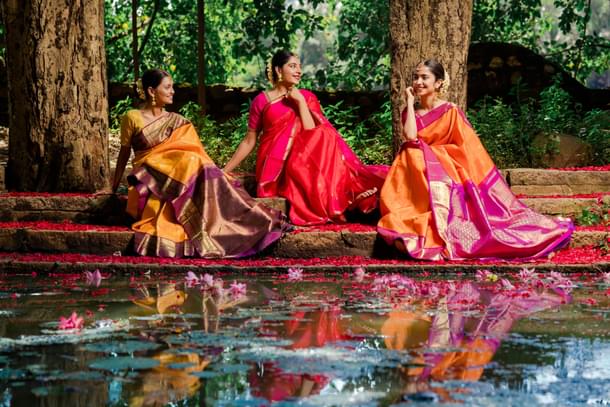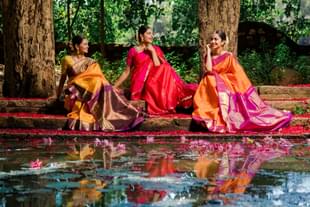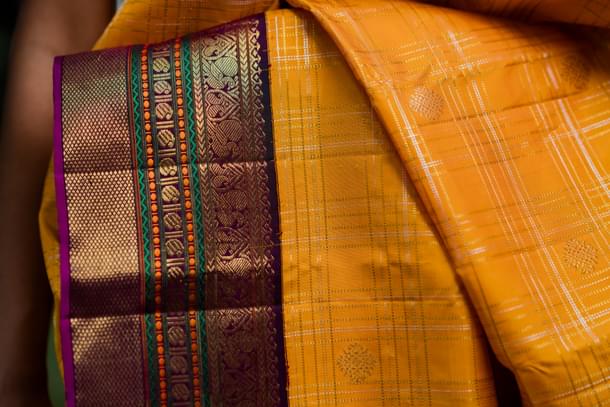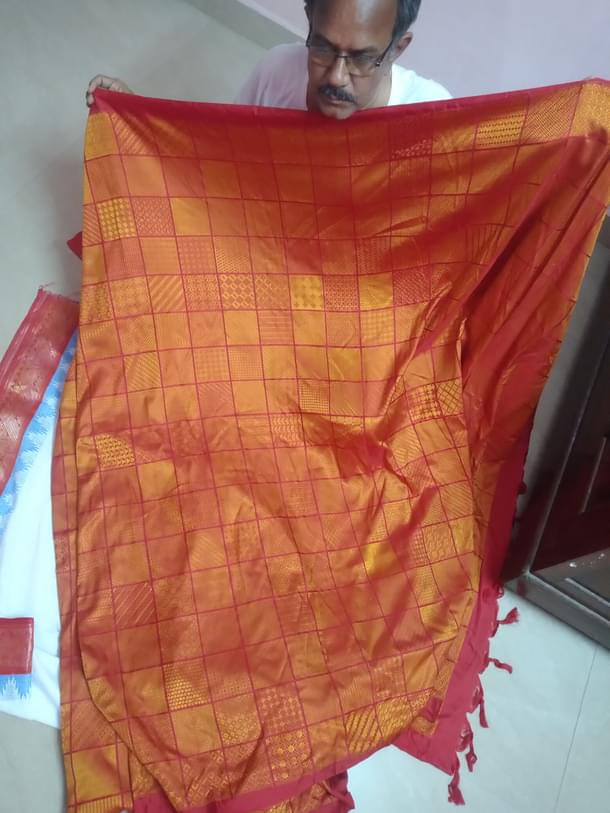Culture
National Handloom Day: What It Takes To Create, Promote And Preserve Kanjeevaram
Ranjani Govind
Aug 07, 2022, 05:40 PM | Updated 05:40 PM IST
Save & read from anywhere!
Bookmark stories for easy access on any device or the Swarajya app.


Think of hand-woven fabric and saris, and India’s signature assortment in weaves come into beckoning. It is the inspiration of the cultural ethos of the weavers. It is to India’s credit that every hurdle for survival has been addressed since Centuries, be it during the British colonial supremacy or the emergence of power loom. The evolution saw the Indian weavers and textile enthusiasts spearheading several movements navigating through whirlwinds that tried to uproot the legacy.
But thanks to a few hundreds of weavers in every State, their steely nerve to anchor themselves to their ancestral legacy stood by us. Today, India still boasts of a strong product identity and the variety in weaves represent the diversity of each State and assert the artistry of the weaver.
“Don’t call it a thread, it’s the sacred yarn we pray to, before starting our weave on the loom,” reminds 61-year-old Kanjeevaram weaver B Krishnamoorthy while he displays and explains the weft and warp of his recent weave he is working on at Kanchipuram in Tamil Nadu.
The National Awardee talks of his jacquard weave in sky blue where he has intricately woven flora and fauna that merges with the texture so amicably that the marriage of ideas, weave and motifs could be mistaken for being a Benarasi with a silver zari!
“I did this sari-series in seven pastel colours for arts revival boutique Madhurya Creations in Bengaluru for a special youth series in silk that they are bringing about for the festive season this year,” says Krishnamoorthy, a third-generation weaver and a 2010 national awardee settled in Kanchipuram.
Several textile revivalists and brands dealing with Kanjeevaram weavers have custom-made creations to help preserve the timeless artistry, both in the traditional-styled and contemporary versions in design.
“Just as the classic tones of chilli reds, turmeric yellows, parrot and leaf greens, the famous peacock blue and arakku (a divine reddish-maroon) are part of the time-honoured shades of a Kanjeevaram sari one can relate to a plenty of figurative motifs and mythical birds, Ghanda-Bherunda, Yazhi or Hamsa, that the heritage weave is associated with, for a harmonious coming together of diverse energies of positivity, courage and strength.
"We can educate youth on this and appreciate what our tradition represents", says Bharathy who passionately designs bridal collections from legacy weavers. The revival boutique referred to above, Madhurya Creations, sources cotton and silk saris and fabrics from around 1080 weavers across India to help them have their looms going, and preserve a heritage. “The Yazhi motif is a symbol of harmony. The bride wearing the sari with these motifs adds harmony to the family she becomes part of and plays a key role in keeping the varied mindsets together,” she says.
Kanjeevarams originally had motifs drawn from nature with striking names - Rudraksha for round; Annapakshi for the swan; chakra for the wheel; temple border for the zig-zags; yazhi for the lion-sphinx-like creature; Ganda Bherunda for a mythical two-headed bird representing royal majesty and grace; and mubbagam for the three-coloured saris. Kanjeevaram sari represents a coming together of traditions that thrived under the royal patronage of dynasties as Chola, Pandyas, Vijayanagar Empire, Nawabs of Arcot and the British dynasty. Through these times Kanjivaram silk industry continued to thrive in the journey.
The looms of Kanchipuram
Popularly known as the ‘City of Silk’ and the ‘City of 1000 temples,’ Kanchipuram, 70 kms away from Chennai, is synonymous with handwoven silk saris.
The Kanjeevaram silks take their name from the old British reference to the town, ‘Conjeevaram‘ while this silk in 2005 was recognised with a Gl tag for its unique traditional designs and weaving method.
The saris made from mulberry silk, procured from Karnataka, adds to the dense fabric’s rich luster and smooth finish to highlight the rich zari (silver threads coated in gold) sourced from Surat in Gujarat. There are more than 7,000 families and 60,000 weavers involved in producing silk saris in Kanchipuram, apart from other parts of Tamil Nadu as Mannargudi, Kumbakonam and Rasipuram making the weave, albeit, much lighter ones that have gained a traction in the market for creating affordable options.
Built-in looms are part of every home here. “For the yarn dyeing process, we use boiling water in copper containers and add dye powder, a mild mixture of soda and soap oil. The signature tones and shades brought in are also due to the water we use from local water bodies that contain specific minerals, apart from water used from boiled rice for gaining stiffness,” says Visalakshi, wife of weaver Selvam, contributing to the family profession. Selvam takes over the weaving with the help of cardboard stencil designs hand-drawn and at times designed on a computer that the younger lot delves in.
Finer points of the weave with contrast borders
Unlike the common single warp used in many sari weaves, the Kanjeevaram silk uses two or three warps dyed in distinct colours and woven in the protracted interlocking technique, locally known as Korvai weave. This allows the use of many colours where the body is woven separately, and the pallu and borders are woven independently. They are joined together sturdily,” says Krishnamoorthy, who has 20 weavers in his fold.
He does not believe in associating the family legacy with bizarre designs to make them pertinent to modern times. Krishnamoorthy’s heart goes out to families, like his own, where children with professional degrees are fast getting into IT professions.


“After passing the 10th, I was fully with my father, master weaver K. Balaraman, for learning the nuances. I can’t expect my children to do that. To have the legacy moving on and help design and textile students enrich themselves, I train them in all aspects of weaving. I have meticulously created a unique textile-manuscript with almost all the Kanjeevaram designs in vogue over centuries on a 60-inch width sari running for 25 metres with 5015 patterns,” says Krishnamoorthy who has perfect drawings/graphs for all the designs for students to follow. “It took me two years to do this Herculean work, as I have been trained in every aspect of the weaving process,” says Krishnamoorthy who earlier worked at Co-Optex as a pattern and graph designer.
That’s not all. Krishnamoorthy has weaved another catalogue of 114 supporting designs with stripes and motifs for borders and pallu with forgotten designs, making his unit become a repository with Kanjeevaram design samples. “My wife is also a 2014 national awardee weaver and together we hope to continue doing the Petni, Korvai and Jaala (adai) work for posterity,” he says.





